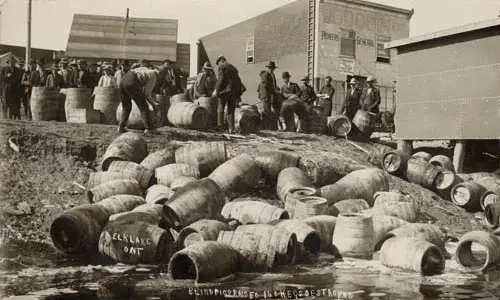In the 18th Amendment to the US Constitution, the manufacture of intoxicating liquor as well as its transportation and sale was banned from the 17th of January 1920. This period is known as Prohibition in American history.
Fact 1 The Noble thought had been tried earlier
Earlier in the 19th century, there were certain groups like the religious revivalists and the American Temperance Society who worked hard to educate people about the evil effects of intoxicating liquor. The activists were supported by a majority of the people and so in 1851, a statewide prohibition law was passed by the Maine legislature and other states too followed suit. But after a few years, riots and opposition spread widely against alcohol ban and so again alcohol began to flow like before.
Fact 2 Consequences of Prohibition of 1920
In the 18th Amendment, the Act was passed against the manufacture, transportation and sale of intoxicating liquor but did not forbid its consumption specifically. So there were some who stacked large quantities of wine, beer or spirits before January 17th 1920, and enjoyed their drinks freely but only at home. Although the number of such buyers was not huge, yet there were some who had bought an entire store and built wine cellars so that they could enjoy them legally.
Fact 3 Prohibition was not enforced by all states
It was not that all states followed the Prohibition Act rather some of them refused to enforce the law although the 18th Amendment as well as the Volstead Act ordered the states to enforce Prohibition within their respective borders. But Maryland never took even a step forward to enforce this law and remained stubborn in its attitude. Later New York also went against Prohibition followed by other states and repealed its measures in 1923. According to the Maryland Senator, the Act was not practically enforced except in a few highly qualified measures.
Fact 4 The sale of alcohol by drug stores as medicine
According to the Volstead Act, there were certain areas that were exempted from alcohol ban. Sacramental wine was permitted and medicinal whiskey could be sold by drug stores to treat even the simplest of health problems like flu and toothaches. Patients could purchase hard liquor on presenting a doctor’s prescription. Thus a chain of such drug stores increased and their sales too with drug stores going up to 500 in number.
Fact 5 Positive effects of Prohibition
It is not that all Americans were against the 18th Amendment Act of Prohibition in 1920. The educated and responsible citizens realized the need for curbing the consumption of alcohol as an evil of the society. According to research carried out by Boston University and M.I.T. economists in the earlier part of 1990s, consumption of alcohol was 70% less during the early stages of the experiment. However, gradually the percentage began to fall due to opposition of many states but was as low as 30% even after the 21st Amendment Act was passed. There are some states that maintain the ban on alcohol after the repeal of Prohibition within their own borders. Kansas and Oklahoma strictly followed the law and remained dry states till 1948 and 1959 respectively. Mississippi remained alcohol free until 1966, even though the 21st Amendment Act was passed 33 years ago. There are 10 states today also that prohibit the sale of alcohol.
Fact 6 21st Amendment to the Constitution
Violence, illegal production and sale of liquor and increase in illegal drinking spots and crimes led to decrease in the support of Prohibition. After the 21st Amendment, it was ratified by the year-end thus bringing the era of Prohibition to an end.











Leave a Reply